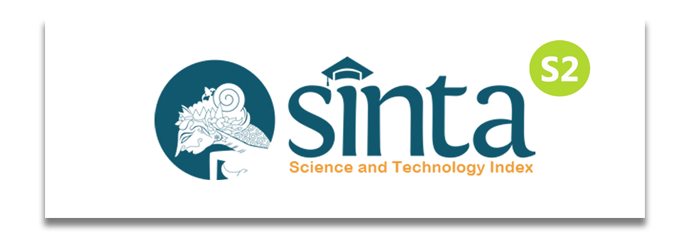The Concordance of Three Diagnostic Test for Malassezia folliculitis using Potassium Hydroxide 20% + Blue-Black Parker Ink, May Grunwald Giemsa, and Potassium Hydroxide 10% + Chicago Sky Blue
Downloads
Background: Malassezia folliculitis is a pilosebaceous follicular infection disease caused by Malassezia species. There are many misdiagnosed Malassezia folliculitis cases, causing the maladministration of therapy. A routine diagnostic test performed for Malassezia folliculitis cases is the identification of fungal elements (spore) with a microscope using potassium hydroxide, but it has several weaknesses. Purpose: To evaluate the suitability of Malassezia folliculitis diagnostic test using Potassium Hydroxide 20% + Blue-Black Parker Ink, May Grunwald Giemsa, and Potassium Hydroxide 10% + Chicago Sky Blue. Methods: Analytic observational study conducted in the Dermatomycology Division of Dermatology and Venereology outpatient clinic, Dr. Soetomo General Hospital Surabaya. The samples were thirty patients with clinical features of Malassezia folliculitis. The research material was obtained from the body as many as three pieces of papulomoluscoid lesion extracted. The material obtained was then divided into three glass objects for Potassium Hydroxide 20% + Blue-Black Parker Ink, May Grunwald Giemsa, and Potassium Hydroxide 10% + Chicago Sky Blue staining. Result: The identification of spores using Potassium Hydroxide 20% + Blue-Black Parker Ink was 90%, May Grunwald Giemsa was 90%, and Potassium Hydroxide 10% + Chicago Sky Blue was 93% with a value of κ=0.348 and p=0.051. The diagnostic values of May Grunwald Giemsa and Potassium Hydroxide 10% + Chicago Sky Blue were 96.6% sensitivity, 33.3% specificity, 92.9% Positive Predictive Value, and 50 % Negative Predictive Value. Conclusions: There was no significant concordance between May Grunwald Giemsa and Potassium Hydroxide 10% + Chicago Sky Blue with Potassium Hydroxide 20% + Blue-Black Parker Ink in establishing the diagnosis of Malassezia folliculitis. Potassium Hydroxide 20% + Blue-Black Parker Ink is still needed as a routine examination in cases with clinical features of Malassezia folliculitis.
PERDOSKI. Panduan Praktik klinis. In : Widaty S, Soebono H, Nilasari H, Listiawan MY, Siswati AS, Triwahyudi D, Editors. Jakarta. Sekretaria PP PERDOSKI. 2017. p. 101-3.
Miranda E. Malassezia folliculitis. In: Bramono K, Suyoso S, Indriatmi W, Ramali LM, Widaty S, Ervianti E, editor. Dermatomikosis superfisialis. Edisi ke-2. Jakarta: Badan Penerbit FKUI. 2013. p. 35-40.
Craft N. Superficial cutaneous infections and pyodermas. In: Goldsmith L.A, Katz S.I, Gilchrest BA, Paller AS, Leffell DJ, Wolf K, editors. Fitzpatrick'sdermatology in the general medicine. 8th ed. New York: The McGraw-Hill Companies Inc. 2012. p. 2128-47.
Hay RJ, Ashbee HR. Fungal Infection : Malassezia folliculitis. In: Griffiths C, Barker J, Bleiker T, Chalmers R, Creamer D, editors. Rook's Textbook of Dermatology. 9th ed. Volume 1. United Kingdom: John Wiley & Sons, Ltd. 2016. p. 3213-15.
Kundu RV, Garg A. Yeast Infection : Candidiasis, Tinea (Pityriasis Versicolor), and Malassezia (Pityriasis) Folicullitis. In: Wolff K, Goldsmith LA, Katz SI, Gilchrest BA, Paller AS, Leffell DJ, editors. Fitzpatricks's Dermatology in General Medicine. 8th ed. New York: The McGraw-Hill Companies. 2012. p. 2298-311.
Pravitasari DN, Suyoso S, Ervianti E. Profil Malassezia Folliculitis. Berkala Ilmu Kesehatan Kulit Kelamin 2015;27(2): 121-9.
Velegraki A, Cafarchia C, Gaitanis G, Latta R, Boekhout T. Malassezia Infections in humans and animals: pathophysiology, detection, and treatment. Plos Pathog 2015; 11(1): 1-6.
Rubenstein RM, Malerich SA. Case report and literature review: Malassezia (Pityrosporum) Folliculitis. J Clin Aesthet Dermatol 2014; 7(3): p. 37-41.
Prindaville B, Belazarian L, Levin NA, Wiss K. Pityrosporum folliculitis: a retrospective review of 110 cases. J Am Acad Dermatol 2017; 2: 1-16.
Al Hawsawi K, Altalhi S, Alwafi D, Aldosari M. Pityrosporum folliculitis: a case report. Dermatol Open J 2019; 3(1): 17-18.
Ariyanti P, Hidayati AN, Suyoso S. Perbandingan pemeriksaan May Grunwald Giemsa (MGG) dan Potassium Hidroxide (KOH) pada pasien Malassezia folliculitis di Unit Rawat Jalan Kesehatan Kulit dan Kelamin Dr. Soetomo General Hospital Surabaya. Berkala Ilmu Kesehatan Kulit Kelamin 2017; 29(3): 195-203.
Thayikkannu AB, Kindo AJ, Veearaghavan M. Malassezia-Can it be Ignored ?. Indian J Dermatol 2015; 60(4): 332–39.
Tsai YC, Wang JY,Wu YH, Wang YJ. Clinical Differences in Pediatric and Adult Malassezia Folliculitis: retrospective analysis of 321 cases over 9 years. J Am Acad Dermatol 2019; 81(1): 278-80.
Durdu M, Guran M, Ilkit M. Epidemiological characteristics of Malassezia folliculitis and use of the May-Grünwald-Giemsa stain to diagnose the Infection. Diagnosis in Microbiology Infection Disease 2013; 76: 450-7.
Purnak S, Durdu M, Tekindal MA, Gulec TA et al. The Prevalence of malassezia folliculitis in patients with papulopustular/comedonal acne, and their response to antifungal treatment. Skinmed 2018; 16: 99-104.
Suzuki C, Hase M, Shimoyama H, Sei Y. Treatment Outcomes for Malassezia Folliculitis in The Dermatology Department of a University Hospital in Japan. Med Mycol J 2016; 57(3): E63-6.
Piotr B, Danuta K. Malassezia folliculitis on the neck. N Dermatol 2010; 1(2): 22-5.
Horobin RW. Dis-, tris- and polyazo dyes. Dalam: Horobin RW, Kiernan J. Conn's biological stains: A handbook of dyes, stains and fluorochromes for use in biology and medicine. 10th ed. Oxford, UK: BIOS Scientific Publishers 2002. p. 125-44.
Argentina F, Rusmawardiana, Thaha MA, Tjekyan RMS. Nilai Diagnostik Larutan Chicago Sky Blue pada Pityriasis versikolor di RSUP Dr. Mohammad Hoesin Palembang. MDVI 2016; 43(1): 17-24.
Noviandini A, Suyoso S, Astari L. Pemeriksaan pewarnaan kalium hidroksida (KOH) 20% tinta ParkerTM blue black, chicago sky blue (CSB), dan kultur jamur di Divisi Dermatomikologi Unit Rawat Jalan Kesehatan Kulit dan Kelamin Dr. Soetomo General Hospital Surabaya. Berkala Ilmu Kesehatan Kulit Kelamin 2017; 29(1): 21-9.
- Copyright of the article is transferred to the journal, by the knowledge of the author, whilst the moral right of the publication belongs to the author.
- The legal formal aspect of journal publication accessibility refers to Creative Commons Atribusi-Non Commercial-Share alike (CC BY-NC-SA), (https://creativecommons.org/licenses/by-nc-sa/4.0/)
- The articles published in the journal are open access and can be used for non-commercial purposes. Other than the aims mentioned above, the editorial board is not responsible for copyright violation
The manuscript authentic and copyright statement submission can be downloaded ON THIS FORM.















